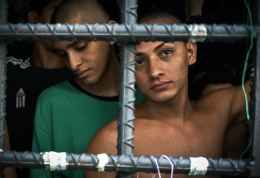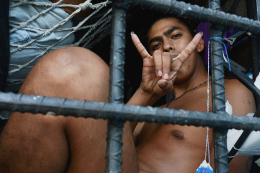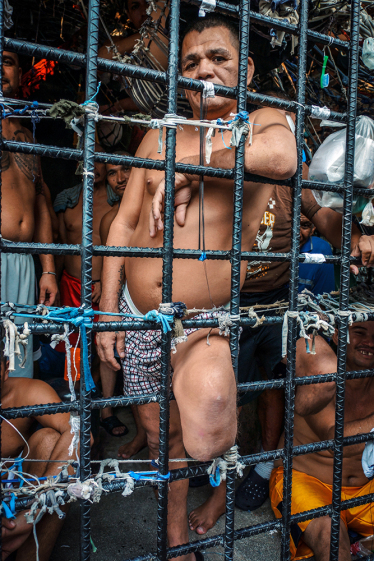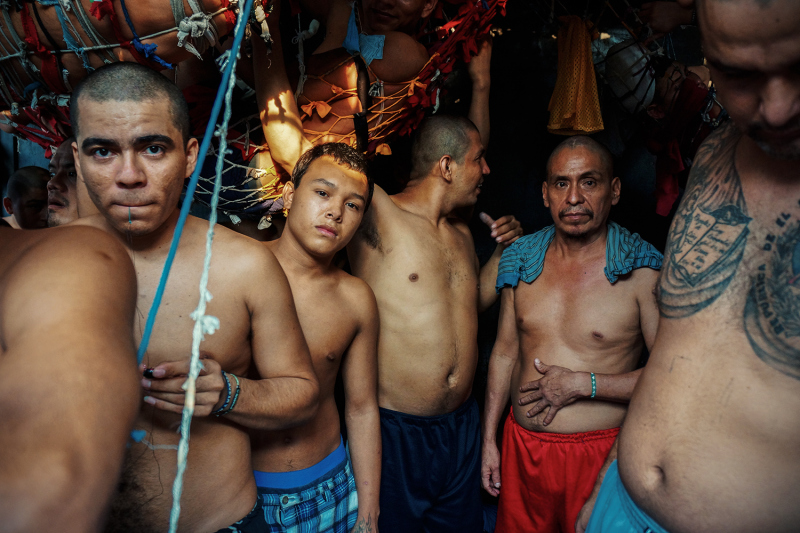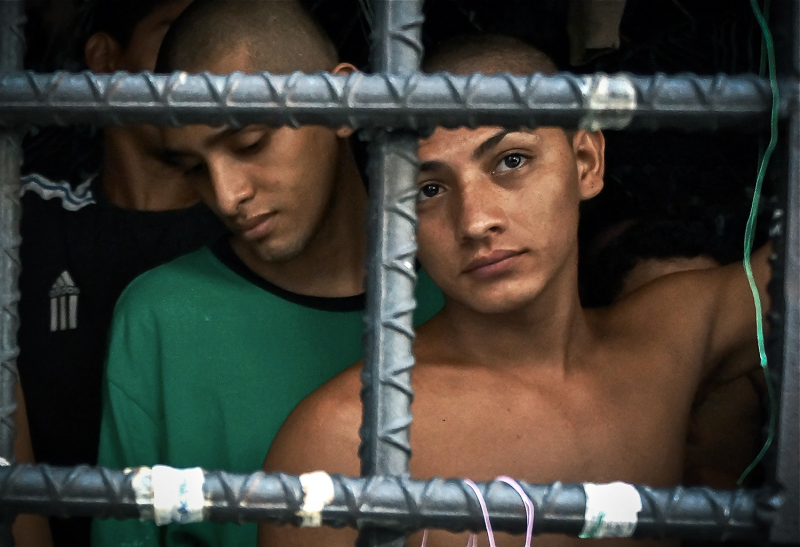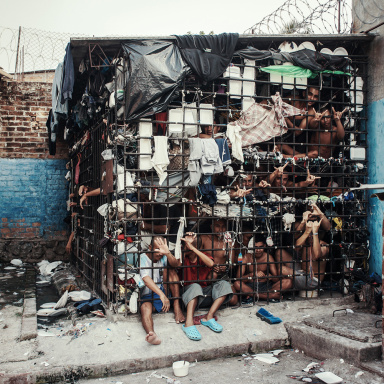In San Salvador, the two main street gangs are known as ‘Mara Salvatruchas’ (MS-13) and ‘Barrio18’ (M18). Both gangs were created in the 1980’s in Los Angeles by poor, mostly illegal immigrants, who had escaped from the civil war in El Salvador. After this brutal civil war had finished and a peace treaty was signed in 1992, many of those in prison for gang-related offenses were deported back to El Salvador where this violent street culture took off. For close to twenty years, these gangs have raged against each other and grown rapidly throughout Latin America. They boast a worldwide membership of over 100,000 active gang members. In 2011, the murder rate peaked at 15 homicides per day in the San Salvador area. A ‘truce’ came in 2012 when a deal between the MS-13 and Barrio18 came to fruition after their leaders were moved from maximum security jails to more comfortable conditions to flesh out the finer details of a peace process. This truce was facilitated by the government and leading church figures. So far, the pact is holding. Homicide figures have dropped down by 50% on pre-truce figures.
Giles Clarke explains how he was given access to the “gang cages”:
Through friends in the country, I joined with a Police Captain and former gang-members who together immersed me into the ‘gang truce’ situation in a rough suburb that’s some 20 miles outside of San Salvador. Over the next few days, I spent time with the special police units patrolling the streets of this particularly troubled area where the two main gangs live and operate. Between the patrols, I spent time with the Police Captain who showed me the inner workings of how they deal with the violence and community unrest between the gangs. He explained how he has recruited women police officers to deal with female domestic and sexual abuse issues and how he provides outreach/support to those previously too scared to talk.
On my last day of shooting, I was in the police station with the Captain who mentioned to me about overcrowding in the El Salvadorian prison system. When I pressed him for more information concerning the overcrowding problem, he offered to show me the ‘gang cages’ in the back of the police station. With 4 armed guards, he led me through to the back.
In a rank and sweltering enclosure ringed by a high, barbed wire wall, there were three, 12×15 ft cages each full of prisoners, one for each gang and another for ‘common criminals’. These cages were designed to be 72-hour holding cells but many have been imprisoned here for over a year and spend their days pulling apart their clothes and sewing together hammocks in which they sleep stacked on top of each other.
In the ‘common criminals’ cage which splits the two ‘gang cages‘, I talked to a one-legged civil war veteran who had been locked up here for over 5 months for ‘protesting’ against the government’s slashing of his medical benefits. It was a shock seeing the terrible conditions that these prisoners were living in. In the ‘Barrio18‘ cage, I met one of the gang bosses, ‘El Sucre’, a recent ‘gang truce’ co-signer representing the ‘Barrio18‘. El Sucre or ‘Henry’, as he called himself, talked to me in hushed tones through the bars about his role in helping disarm his gang of assault weapons as well as introducing Christianity to the younger gang members, many of whom are initiated as early as 10 years old.
After my 30 minutes in the caged enclosure, I was asked to leave. As I left, I asked the Captain if I could return the next morning to further talk to the prisoners, which he agreed to.
The following morning, however, was a very different situation. My time and presence in this usually ‘off-limits’ area had somehow reached the main San Salvador Police Press Department and things were suddenly ‘not safe’ for me to remain and photograph in this area. The Captain then informed me that no photojournalists have been allowed access into this area for over 10 years and it would be advisable for me to leave.
I feel the reason that this sympathetic Police Captain showed me these cages was due to his own complete frustration at the inhumane conditions that he manages and presides over on a daily basis. He mentioned many times about the lack of funding for food, the cramped conditions, and the health problems for these prisoners. Ultimately, he wants to help the gang members hold up this delicate truce. ‘We need a full time doctor here. These cages are full and many are sick. Maybe your pictures can help in some way?’ he remarked.
As I left, I couldn’t help thinking about the Captain and sincerely hoped that the head of the Police Press Department and the Chief Inspector (who were on their way over as I left) would not come down too hard on him. I feel our Captain, a hardened 17 year veteran in this extremely tough neighborhood, had finally reached his limit. Here is a troubled man working hard to implement real improvements to an archaic and embattled justice system.
platformPHOTO: Hi Giles. When you arrived at San Salvador you were not aware of the existence of the ‘gang cages’. Please tell us a bit about the original project you had in mind when you prepared for your trip to San Salvador.
Giles Clarke: I traveled there with another journalist to investigate the fragile ‘gang truce that had been in place for 15 months. We met local politicians, community leaders and ex-gang members-all of whom were working together to try keep the peace by providing employment and amenities in the roughest neighborhoods.
platformPHOTO: What was your immediate reaction when you saw the ‘gang cages’?
Giles Clarke: At first, I couldn’t work out what I was looking at but it soon became apparent. I was looking at three cages stuffed full of men- from floor to ceiling in crude hammocks. The place stank to high heaven and it was very very hot. The captain was standing alongside me and we had 4 armed guards behind us.
I asked the captain:
‘What is this’?
‘This is where we keep the prisoners who are awaiting trial. The prisons are full so we keep them here’.
As I got closer, I realized that each cage was literally full; 35 men in the MS-13 cage alone. Some of them spoke English and told me that some of the prisoners had been in the cages for over 18 months.
platformPHOTO: What are the living conditions like for the prisoners in the ‘gang cages’? How do they cope with living in such close proximity of one another?
Giles Clarke: The conditions are terrible. Firstly, the smell and the heat are unbearable and sanitation is virtually non-existent. They drink water from one large container in the back corner of the cage. Food is bought in by guards but donated by prisoner families. If your family does not know you are there, or you have no family then you beg off other prisoners. The prisoners spend most of the day sewing! They carefully take apart clothing and sew hammocks that are hung across the cages in which they sleep. The real problem, according to the captain, are the health issues that are left untreated for months.
platformPHOTO: Why do prisoners get put in the ‘gang cages’? Do you think it’s more to do with the nature of their crimes or the overcrowding of the prison?
Giles Clarke: There are three cages in this police station- One each for the gangs MS-13 and Barrio18 and one cage for ‘common criminals’. Part of the incarceration is political. The local mayors apparently use these figures to boost their re-election chances by saying they are cracking down on gang-violence. In reality, these men are rounded up then left to rot for months on end with no legal representation or visitors. Of course, the over-crowding in Latin American prisons is well documented and clearly these are spill-over cages but they are also used to limit the organizational ability of some of the more active gang-members who use prison for recruitment purposes. In the ‘common-criminal’ cage I met a one legged man who was a war veteran from the El Salvadorian civil war in the 1980’s. He had been locked up here for 5 months for protesting the cutting of his medical benefits that were slashed last year.
platformPHOTO: Do you feel a sense of responsibility to communicate the plight of these prisoners, given you are the only photojournalist allowed in for 10 years?
Giles Clarke: Yes, of course. I had been with the police captain for a few days and gradually winning his trust. I liked him and, to get deeper into the stories, I needed him. He seemed unusually responsive which I later put down to his frustration at the terrible conditions that he presides over regarding the cages. He showed me the cages and let me photograph them for a reason.
platformPHOTO: Do you think your images have helped raise awareness of and improve the inhumane living conditions of the prisoners as the Police Captain was hoping?
Giles Clarke: I hope so and I do worry about the police captain - I tried calling him recently but his phone has been disconnected. He appeared sympathetic toward the conditions these men are enduring especially on the medical front. He wants a full-time doctor to be on call and that request had fallen on deaf ears when he asked his superiors in San Salvador. Of course, some of the youngest prisoners looked like children so that is a problem but many of the gangs start recruiting kids from aged 10 so its hardly surprising there are many very young offenders -though i was assured all prisoners were 18 and older. I would suspect that these images might make embarrass some of the police leaders and politicians. But I don’t know… There needs to be some kind of reform but it needs to come from the top and be sweeping in its reach. I hope that these images help communicate the hopelessness of the El Salvadorian judicial system and possibly effect some kind of change.
platformPHOTO: Have you heard back from the Police Captain? Has he managed to get a doctor for the prisoners and some allowances for food?
Giles Clarke: No, unfortunately I have not heard from the captain.
platformPHOTO: Did you find out if the Police Captain got into trouble with the head of the Police Department and the Chief Inspector for giving you access to document the ‘gang cages’?
Giles Clarke: When I left the police station, the police captain told me he was dealing with the central police press department who were unhappy that I had been allowed in to photograph the cages. I left before I found out what happened.
platformPHOTO: What was the reaction of the prisoners when they saw you arriving with your photographic equipment?
Giles Clarke: The prisoners here do not get any visitors so when they saw me, they were very receptive to my being there. They were, for the most part, happy to be photographed. Many of those in the gang cages had been deported from the US so spoke good English. I spent time talking with them about why they were there and what is was like to be there. A few times, I put my camera thru the bars and snapped images inside the cages- I was weary at first but was quickly made to feel welcome… if that sounds right!
platformPHOTO: You mentioned that some prisoners have been in the gang cages for over a year. Do you know if they’re allowed any time out of the cages at all? Perhaps walking in a guarded area or staying in a larger room few hours a day where they can stretch their legs.
Giles Clarke: Every Thursday, a special armed unit arrives from San Salvador (20 miles away) to help clean out the cages. Once a week the prisoners are chained at the feet and hands and escorted out of the cages for one hour while the cells are disinfected and ‘searched for contraband’. Other than that, there is no exercise or freedom allowed.
platformPHOTO: What was it like to be told on your second visit to the ‘gang cages’ that it was not safe for you to stay before being advised to leave? Did you feel threatened? If so, did you question whether to put these images in to the public domain?
Giles Clarke: I was advised by the police captain to leave and not come back. He suggested I leave the country as soon as possible. I had already dropped the images onto a ‘image cloud’ so they would be safe despite whatever happened to me.
platformPHOTO: What would your advice be to emerging photojournalists when faced with situations such as these?
Giles Clarke: What I learn from this experience was the importance of talking to everyone concerned. I would not have got these pictures if I had not spent the hours talking with the police captain and hearing his problems. In this situation, it was not about running in with a camera and snapping away. It was about wanting to understand the underlying issues and spending time exploring the story. I was fortunate that the captain let me in but equally I feel it was our chemistry that ultimately led me into the caged enclosure. I think of these prisoners everyday which is a little odd- but given the conditions they live in, I cannot help but be concerned.
To view more of Giles’ work please visit his website: http://www.gilesnclarke.com/


